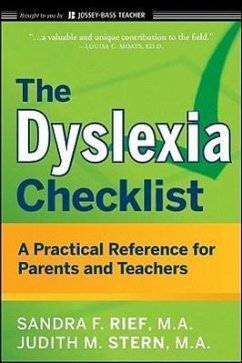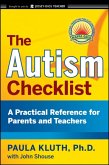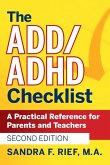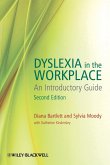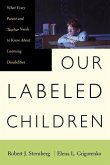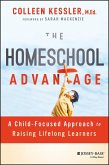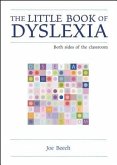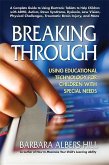15,99 €
inkl. MwSt.
Versandfertig in über 4 Wochen

8 °P sammeln
- Broschiertes Buch
- Merkliste
- Auf die Merkliste
- Bewerten Bewerten
- Teilen
- Produkt teilen
- Produkterinnerung
- Produkterinnerung
Essential advice and resources for helping kids with dyslexia The Dyslexia Checklist is a valuable guide for parents and teachers that can help them better understand children and teenagers with dyslexia and other reading- and language-based disabilities.
Andere Kunden interessierten sich auch für
![The Autism Checklist The Autism Checklist]() Paula KluthThe Autism Checklist19,99 €
Paula KluthThe Autism Checklist19,99 €![The Add / ADHD Checklist The Add / ADHD Checklist]() Sandra F. RiefThe Add / ADHD Checklist17,99 €
Sandra F. RiefThe Add / ADHD Checklist17,99 €![Dyslexia in the Workplace 2e Dyslexia in the Workplace 2e]() Diana Bartlett (Independent dyslexia trainer and consultant)Dyslexia in the Workplace 2e40,99 €
Diana Bartlett (Independent dyslexia trainer and consultant)Dyslexia in the Workplace 2e40,99 €![Our Labeled Children Our Labeled Children]() Elena GrigorenkoOur Labeled Children23,99 €
Elena GrigorenkoOur Labeled Children23,99 €![The Homeschool Advantage The Homeschool Advantage]() Colleen Kessler (Raising Lifelong Learners)The Homeschool Advantage26,99 €
Colleen Kessler (Raising Lifelong Learners)The Homeschool Advantage26,99 €![The Little Book of Dyslexia The Little Book of Dyslexia]() Joe BeechThe Little Book of Dyslexia16,99 €
Joe BeechThe Little Book of Dyslexia16,99 €![Breaking Through Breaking Through]() Barbara Albers Hill (Barbara Albers Hill)Breaking Through15,99 €
Barbara Albers Hill (Barbara Albers Hill)Breaking Through15,99 €-
-
-
Essential advice and resources for helping kids with dyslexia The Dyslexia Checklist is a valuable guide for parents and teachers that can help them better understand children and teenagers with dyslexia and other reading- and language-based disabilities.
Hinweis: Dieser Artikel kann nur an eine deutsche Lieferadresse ausgeliefert werden.
Hinweis: Dieser Artikel kann nur an eine deutsche Lieferadresse ausgeliefert werden.
Produktdetails
- Produktdetails
- J-B Ed: Checklist
- Verlag: John Wiley & Sons Inc
- Seitenzahl: 336
- Erscheinungstermin: 1. Januar 2010
- Englisch
- Abmessung: 227mm x 154mm x 27mm
- Gewicht: 396g
- ISBN-13: 9780470429815
- ISBN-10: 047042981X
- Artikelnr.: 27064755
- Herstellerkennzeichnung
- Libri GmbH
- Europaallee 1
- 36244 Bad Hersfeld
- gpsr@libri.de
- J-B Ed: Checklist
- Verlag: John Wiley & Sons Inc
- Seitenzahl: 336
- Erscheinungstermin: 1. Januar 2010
- Englisch
- Abmessung: 227mm x 154mm x 27mm
- Gewicht: 396g
- ISBN-13: 9780470429815
- ISBN-10: 047042981X
- Artikelnr.: 27064755
- Herstellerkennzeichnung
- Libri GmbH
- Europaallee 1
- 36244 Bad Hersfeld
- gpsr@libri.de
Sandra F. Rief, M.A., is an internationally known speaker, consultant, and best-selling author of books on helping children with learning disabilities and ADHD. A former award-winning special educator, she is author or co-author of nunerous books including How to Reach and Teach All Children in the Inclusive Classroom and the ADHD Checklist. Find more information at her website, www.sandrarief.com. Judith M. Stern, M.A., is a teacher, educational consultant, and national speaker, who specializes in helping children with learning and attention problems. Her past books include Putting on the Brakes: Understanding and Taking Control of Your ADD or ADHD. For her consulting, presentation, and tutoring topics, visit her website, www.JudithSternEducationalConsultant.com.
Acknowledgments xiii
About the Authors xv
Introduction xvii
1. Basic information on dyslexia 1
Introduction 2
1.1. Clarifying the Terms Dyslexia and Learning Disabilities 3
1.2. Important Facts and General Information About Dyslexia 7
1.3. Signs and Symptoms of Dyslexia 11
1.4. Decades of Research: What We Now Know About Dyslexia 16
1.5. Other Common Problems 20
1.6. Common Strengths and Positive Characteristics of People with Dyslexia
25
1.7. Diagnosing Dyslexia 27
1.8. Research-Based Intervention Programs for Struggling Readers 35
1.9. What Children with Dyslexia Need from Parents and Teachers 43
1.10. Key Instructional Components and Interventions for Students with
Dyslexia 45
1.11. Dual or Multiple Exceptionalities (Gifted and Dyslexic) 50
Resources 54
2. Strategies for helping with reading, language, and writing 57
Introduction 58
2.1. Phonological Awareness 59
2.2. Systematic Phonics 67
2.3. Decoding Strategies 73
2.4. Sight Word and Irregular Word Strategies 86
2.5. Fluency Strategies 91
2.6. Vocabulary Strategies 98
2.7. Comprehension Strategies 104
2.8. Spelling 115
2.9. Common Writing Difficulties for Children with Dyslexia 126
2.10. Strategies to Help with Prewriting: Planning and Organizing 129
2.11. Strategies for Teaching Composition and Written Expression 133
2.12. Strategies to Help with Revising and Editing 140
2.13. Assistive Technology to Support Reading and Writing 146
2.14. Accommodating Reading and Writing Difficulties 154
2.15. Games and Activities to Strengthen Literacy and Language Skills 159
2.16. The Basic Spelling Vocabulary List 163
Resources 169
3. Checklists for parents 177
Introduction 177
3.1. Talking with Your Child About Dyslexia and Other Learning Differences
178
3.2. How to Advocate for Your Child 182
3.3. Finding a Tutor or Educational Therapist 187
3.4. Building and Nurturing Your Child's Self-Esteem 191
3.5. How to Help Your Child with Homework 195
3.6. Reinforcing Reading Skills at Home 201
3.7. Helping Your Child with Organization and Time Management 206
3.8. Strategies for Building Your Child's Study Skills 213
Resources 218
4. Checklists for teachers 221
Introduction 221
4.1. Adaptations, Accommodations, and Modifications: What's the Difference?
222
4.2. How Teachers Can Help Students with Homework 226
4.3. Differentiating Instruction 232
4.4. Adaptations and Modifications of Materials 237
4.5. Adaptations and Accommodations in Testing 240
4.6. Helping Students with Organization and Time Management 246
4.7. Strategies to Aid Memory 253
4.8. Strategies for Teaching Reading in the Content Areas 258
Resources 263
5. Other important checklists for parents and teachers 265
Introduction 265
5.1. High School Students with Dyslexia 266
5.2. College Students with Dyslexia 270
5.3. Response to Intervention 274
5.4. Special Education 282
5.5. Individualized Education Plans 287
5.6. Section 504 290
5.7 National Organizations and Resources That Address Disability Issues 294
Resources 298
Index 303
About the Authors xv
Introduction xvii
1. Basic information on dyslexia 1
Introduction 2
1.1. Clarifying the Terms Dyslexia and Learning Disabilities 3
1.2. Important Facts and General Information About Dyslexia 7
1.3. Signs and Symptoms of Dyslexia 11
1.4. Decades of Research: What We Now Know About Dyslexia 16
1.5. Other Common Problems 20
1.6. Common Strengths and Positive Characteristics of People with Dyslexia
25
1.7. Diagnosing Dyslexia 27
1.8. Research-Based Intervention Programs for Struggling Readers 35
1.9. What Children with Dyslexia Need from Parents and Teachers 43
1.10. Key Instructional Components and Interventions for Students with
Dyslexia 45
1.11. Dual or Multiple Exceptionalities (Gifted and Dyslexic) 50
Resources 54
2. Strategies for helping with reading, language, and writing 57
Introduction 58
2.1. Phonological Awareness 59
2.2. Systematic Phonics 67
2.3. Decoding Strategies 73
2.4. Sight Word and Irregular Word Strategies 86
2.5. Fluency Strategies 91
2.6. Vocabulary Strategies 98
2.7. Comprehension Strategies 104
2.8. Spelling 115
2.9. Common Writing Difficulties for Children with Dyslexia 126
2.10. Strategies to Help with Prewriting: Planning and Organizing 129
2.11. Strategies for Teaching Composition and Written Expression 133
2.12. Strategies to Help with Revising and Editing 140
2.13. Assistive Technology to Support Reading and Writing 146
2.14. Accommodating Reading and Writing Difficulties 154
2.15. Games and Activities to Strengthen Literacy and Language Skills 159
2.16. The Basic Spelling Vocabulary List 163
Resources 169
3. Checklists for parents 177
Introduction 177
3.1. Talking with Your Child About Dyslexia and Other Learning Differences
178
3.2. How to Advocate for Your Child 182
3.3. Finding a Tutor or Educational Therapist 187
3.4. Building and Nurturing Your Child's Self-Esteem 191
3.5. How to Help Your Child with Homework 195
3.6. Reinforcing Reading Skills at Home 201
3.7. Helping Your Child with Organization and Time Management 206
3.8. Strategies for Building Your Child's Study Skills 213
Resources 218
4. Checklists for teachers 221
Introduction 221
4.1. Adaptations, Accommodations, and Modifications: What's the Difference?
222
4.2. How Teachers Can Help Students with Homework 226
4.3. Differentiating Instruction 232
4.4. Adaptations and Modifications of Materials 237
4.5. Adaptations and Accommodations in Testing 240
4.6. Helping Students with Organization and Time Management 246
4.7. Strategies to Aid Memory 253
4.8. Strategies for Teaching Reading in the Content Areas 258
Resources 263
5. Other important checklists for parents and teachers 265
Introduction 265
5.1. High School Students with Dyslexia 266
5.2. College Students with Dyslexia 270
5.3. Response to Intervention 274
5.4. Special Education 282
5.5. Individualized Education Plans 287
5.6. Section 504 290
5.7 National Organizations and Resources That Address Disability Issues 294
Resources 298
Index 303
Acknowledgments xiii
About the Authors xv
Introduction xvii
1. Basic information on dyslexia 1
Introduction 2
1.1. Clarifying the Terms Dyslexia and Learning Disabilities 3
1.2. Important Facts and General Information About Dyslexia 7
1.3. Signs and Symptoms of Dyslexia 11
1.4. Decades of Research: What We Now Know About Dyslexia 16
1.5. Other Common Problems 20
1.6. Common Strengths and Positive Characteristics of People with Dyslexia
25
1.7. Diagnosing Dyslexia 27
1.8. Research-Based Intervention Programs for Struggling Readers 35
1.9. What Children with Dyslexia Need from Parents and Teachers 43
1.10. Key Instructional Components and Interventions for Students with
Dyslexia 45
1.11. Dual or Multiple Exceptionalities (Gifted and Dyslexic) 50
Resources 54
2. Strategies for helping with reading, language, and writing 57
Introduction 58
2.1. Phonological Awareness 59
2.2. Systematic Phonics 67
2.3. Decoding Strategies 73
2.4. Sight Word and Irregular Word Strategies 86
2.5. Fluency Strategies 91
2.6. Vocabulary Strategies 98
2.7. Comprehension Strategies 104
2.8. Spelling 115
2.9. Common Writing Difficulties for Children with Dyslexia 126
2.10. Strategies to Help with Prewriting: Planning and Organizing 129
2.11. Strategies for Teaching Composition and Written Expression 133
2.12. Strategies to Help with Revising and Editing 140
2.13. Assistive Technology to Support Reading and Writing 146
2.14. Accommodating Reading and Writing Difficulties 154
2.15. Games and Activities to Strengthen Literacy and Language Skills 159
2.16. The Basic Spelling Vocabulary List 163
Resources 169
3. Checklists for parents 177
Introduction 177
3.1. Talking with Your Child About Dyslexia and Other Learning Differences
178
3.2. How to Advocate for Your Child 182
3.3. Finding a Tutor or Educational Therapist 187
3.4. Building and Nurturing Your Child's Self-Esteem 191
3.5. How to Help Your Child with Homework 195
3.6. Reinforcing Reading Skills at Home 201
3.7. Helping Your Child with Organization and Time Management 206
3.8. Strategies for Building Your Child's Study Skills 213
Resources 218
4. Checklists for teachers 221
Introduction 221
4.1. Adaptations, Accommodations, and Modifications: What's the Difference?
222
4.2. How Teachers Can Help Students with Homework 226
4.3. Differentiating Instruction 232
4.4. Adaptations and Modifications of Materials 237
4.5. Adaptations and Accommodations in Testing 240
4.6. Helping Students with Organization and Time Management 246
4.7. Strategies to Aid Memory 253
4.8. Strategies for Teaching Reading in the Content Areas 258
Resources 263
5. Other important checklists for parents and teachers 265
Introduction 265
5.1. High School Students with Dyslexia 266
5.2. College Students with Dyslexia 270
5.3. Response to Intervention 274
5.4. Special Education 282
5.5. Individualized Education Plans 287
5.6. Section 504 290
5.7 National Organizations and Resources That Address Disability Issues 294
Resources 298
Index 303
About the Authors xv
Introduction xvii
1. Basic information on dyslexia 1
Introduction 2
1.1. Clarifying the Terms Dyslexia and Learning Disabilities 3
1.2. Important Facts and General Information About Dyslexia 7
1.3. Signs and Symptoms of Dyslexia 11
1.4. Decades of Research: What We Now Know About Dyslexia 16
1.5. Other Common Problems 20
1.6. Common Strengths and Positive Characteristics of People with Dyslexia
25
1.7. Diagnosing Dyslexia 27
1.8. Research-Based Intervention Programs for Struggling Readers 35
1.9. What Children with Dyslexia Need from Parents and Teachers 43
1.10. Key Instructional Components and Interventions for Students with
Dyslexia 45
1.11. Dual or Multiple Exceptionalities (Gifted and Dyslexic) 50
Resources 54
2. Strategies for helping with reading, language, and writing 57
Introduction 58
2.1. Phonological Awareness 59
2.2. Systematic Phonics 67
2.3. Decoding Strategies 73
2.4. Sight Word and Irregular Word Strategies 86
2.5. Fluency Strategies 91
2.6. Vocabulary Strategies 98
2.7. Comprehension Strategies 104
2.8. Spelling 115
2.9. Common Writing Difficulties for Children with Dyslexia 126
2.10. Strategies to Help with Prewriting: Planning and Organizing 129
2.11. Strategies for Teaching Composition and Written Expression 133
2.12. Strategies to Help with Revising and Editing 140
2.13. Assistive Technology to Support Reading and Writing 146
2.14. Accommodating Reading and Writing Difficulties 154
2.15. Games and Activities to Strengthen Literacy and Language Skills 159
2.16. The Basic Spelling Vocabulary List 163
Resources 169
3. Checklists for parents 177
Introduction 177
3.1. Talking with Your Child About Dyslexia and Other Learning Differences
178
3.2. How to Advocate for Your Child 182
3.3. Finding a Tutor or Educational Therapist 187
3.4. Building and Nurturing Your Child's Self-Esteem 191
3.5. How to Help Your Child with Homework 195
3.6. Reinforcing Reading Skills at Home 201
3.7. Helping Your Child with Organization and Time Management 206
3.8. Strategies for Building Your Child's Study Skills 213
Resources 218
4. Checklists for teachers 221
Introduction 221
4.1. Adaptations, Accommodations, and Modifications: What's the Difference?
222
4.2. How Teachers Can Help Students with Homework 226
4.3. Differentiating Instruction 232
4.4. Adaptations and Modifications of Materials 237
4.5. Adaptations and Accommodations in Testing 240
4.6. Helping Students with Organization and Time Management 246
4.7. Strategies to Aid Memory 253
4.8. Strategies for Teaching Reading in the Content Areas 258
Resources 263
5. Other important checklists for parents and teachers 265
Introduction 265
5.1. High School Students with Dyslexia 266
5.2. College Students with Dyslexia 270
5.3. Response to Intervention 274
5.4. Special Education 282
5.5. Individualized Education Plans 287
5.6. Section 504 290
5.7 National Organizations and Resources That Address Disability Issues 294
Resources 298
Index 303
